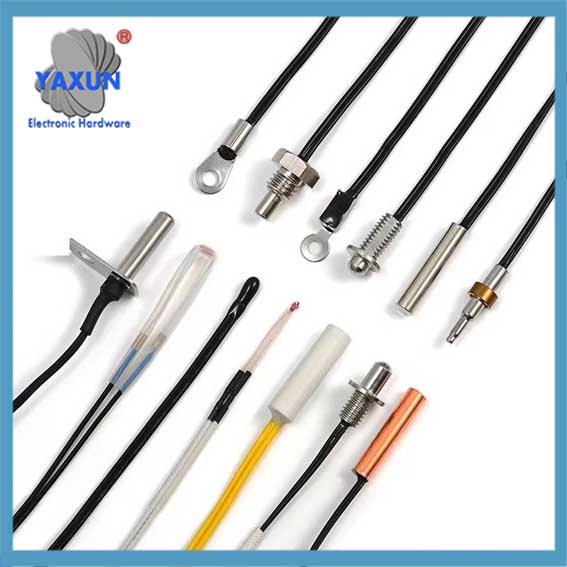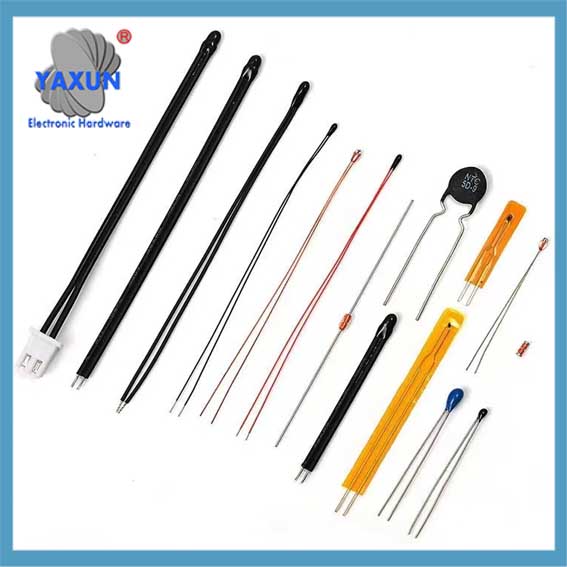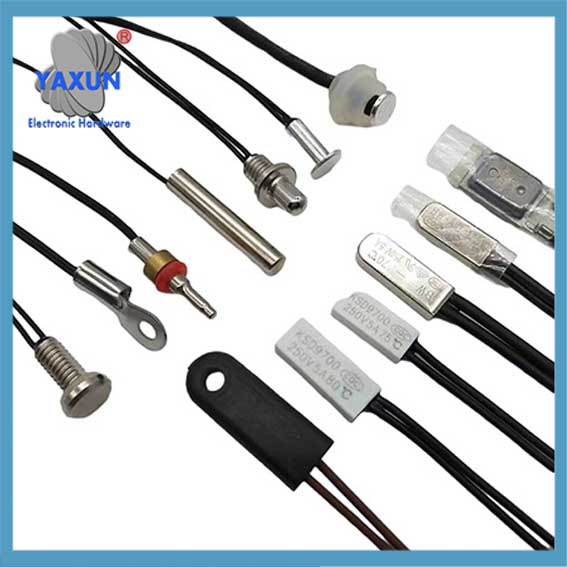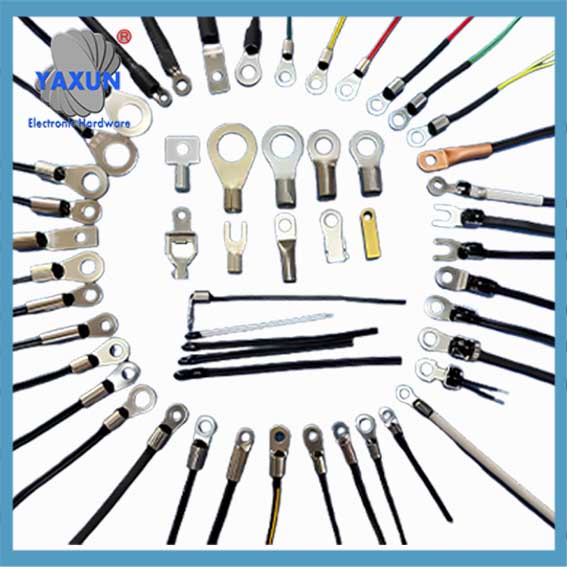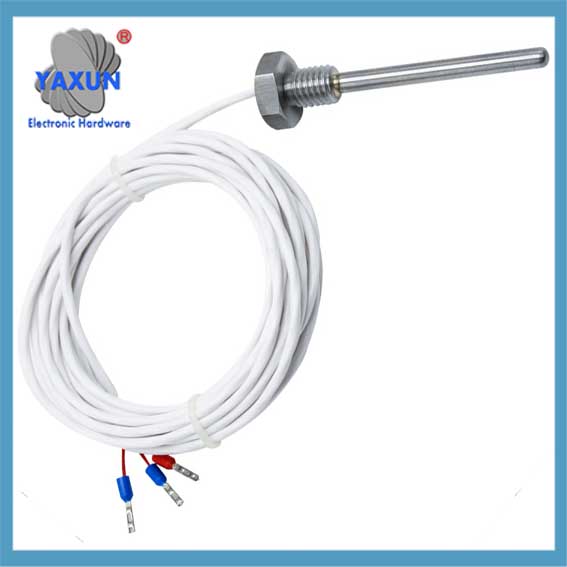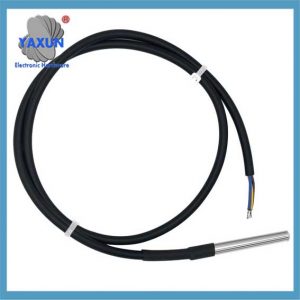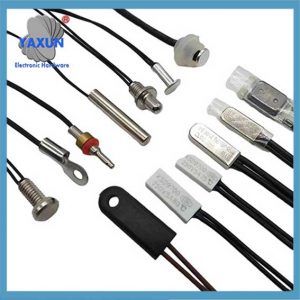Категорії продуктів
- термічний запобіжник 32
- Поверхневе кріплення 12
- термістор 36
- Власник запобіжника кріплення на друковці 27
- Проводка 6
- Власники запобіжників леза 17
- термостат 50
- Електричний запобіжник 24
- Автомобільний датчик температури 7
- Термічний вимикач 22
- Власник коробки 36
- Датчик температури 75
- Тепловий перемикач 68
- Забій 20
- Боллт вниз по запору 8
Теги продукту
Температурні зонди, Типи датчиків температури & програми
Температурний зонд – це пристрій для вимірювання температури, зазвичай складається з чутливого елемента та вимірювальної схеми. Чутливим елементом може бути термопара (pt100, pt1000), терморезистор (ntc, ptc), напівпровідник (DS18B20 цифровий), тощо, який може перетворювати зміни температури в електричні сигнали. Потім він посилюється, фільтрують, перетворений, і обробляється вимірювальною схемою, і, нарешті, виводиться електричний сигнал, пропорційний температурі.
Temperature probes and temperature sensors are two different devices, and they have their own characteristics and application scenarios in measuring temperature.
Temperature Probe
A “temperature probe” is a sensor used to measure temperature by converting the heat energy into a measurable electrical signal, and the most common types of temperature sensors within a probe include thermocouples, Resistance Temperature Detectors (RTD), and thermistors, each with distinct characteristics and applications based on the required accuracy, temperature range, and response time needed for a specific situation.
Definition: Температурний зонд – це пристрій для вимірювання температури, зазвичай складається з чутливого елемента та вимірювальної схеми. Чутливим елементом може бути термопара (pt100, pt1000), терморезистор (ntc, ptc), напівпровідник (DS18B20 цифровий), тощо, який може перетворювати зміни температури в електричні сигнали. Потім він посилюється, фільтрують, перетворений, і обробляється вимірювальною схемою, і, нарешті, виводиться електричний сигнал, пропорційний температурі.
Working Principle: The working principle of the temperature probe is to use the response of the sensitive element to temperature changes to convert temperature changes into electrical signals. Common sensitive elements include thermocouples, терморезистори, напівпровідників, тощо. The working principle of the thermocouple is to use the thermoelectric effect of two different metals or alloys. When they are connected together and at different temperatures, an electromotive force proportional to the temperature is generated. The working principle of the thermal resistor is to use the property that the resistance of metal or semiconductor materials changes with temperature. When the temperature changes, the resistance value will also change accordingly. The working principle of semiconductor is to use the property that the conductivity of semiconductor material changes with temperature. When the temperature changes, the conductivity will also change accordingly.
Type: The types of temperature probes mainly include thermocouple probes, thermal resistor probes, semiconductor probes, тощо. Thermocouple probes use thermocouples as sensitive elements, and have the characteristics of wide measurement range, fast response speed, and high precision. Thermal resistor probes use thermal resistors as sensitive elements, and have the characteristics of high measurement accuracy, хороша стійкість, and strong anti-interference ability. Semiconductor probes use semiconductors as sensitive elements, and have the characteristics of small size, легка вага, and low power consumption.
Application fields: Temperature probes are widely used in industry, scientific research, medical care, environmental protection and other fields. Such as temperature measurement and control in chemical, petroleum, металургія, electricity, фармацевтичний, food and other industries.
DS18B20 Temperature Sensor Cable with Probe
Електропроводка: Червоний(VCC), Yellow(Data), чорний(GND)
Wide temperature range of -55 ℃ ~ +125 ℃
Блок живлення: 3.0V ~ 5.5V
Tips: Using a 4.7K resistor between the Data and VCC will make the testing of the probe easilier.
Thermocouple:
функція: Generates a voltage difference based on the temperature at the junction of two dissimilar metal wires.
Pros: Wide temperature range (-200°C to 1750°C), relatively inexpensive, fast response time.
Cons: Lower accuracy compared to other sensors, requires calibration tables to convert voltage to temperature.
Додатки: High-temperature applications like furnaces, engine monitoring, industrial processes.
Термістор:
Applications of Temperature Probes:
Industrial Processes: Monitoring temperature in manufacturing processes like ovens, reactors, and extruders.
HVAC Systems: Regulating room temperature in buildings by monitoring air temperature.
Безпека харчових продуктів: Monitoring food temperature during cooking and storage to ensure food safety.
Medical Devices: Measuring body temperature in patients through probes inserted into the body.
Automotive Industry: Monitoring engine coolant temperature and cabin temperature.
Наукові дослідження: Precise temperature measurements in experiments.
Датчик температури
Definition: A temperature sensor is a device that can convert temperature changes into electrical signals. It usually consists of a sensitive element and a signal processing circuit. Чутливим елементом може бути термопара, thermal resistor, semiconductor, тощо. The signal processing circuit can be an analog circuit, a digital circuit, тощо, which together complete the acquisition, обробка та виведення температурних сигналів.
Принцип роботи: The working principle of the temperature sensor is similar to that of the temperature probe. It also uses the response of the sensitive element to the temperature change to convert the temperature change into an electrical signal. Проте, the temperature sensor usually has a more complex signal processing circuit, which can perform more advanced processing on the temperature signal, such as digital conversion, data storage, communication, тощо.
Type: The types of temperature sensors mainly include analog temperature sensors, digital temperature sensors, and intelligent temperature sensors. Analog temperature sensors output analog signals, which need to be converted into digital signals through analog-to-digital converters. Digital temperature sensors directly output digital signals, and have the characteristics of strong anti-interference ability, Висока точність, and easy integration. Intelligent temperature sensors have functions such as self-diagnosis, самокалібрування, and communication, і може реалізувати дистанційний моніторинг і контроль.
Features: The temperature sensor has the characteristics of high measurement accuracy, хороша стійкість, Сильна здатність до інтерференцій, and easy integration. Different types of temperature sensors have different characteristics, such as analog temperature sensors require analog-to-digital converters, digital temperature sensors directly output digital signals, and intelligent temperature sensors have functions such as self-diagnosis, самокалібрування, and communication.
Application fields: Temperature sensors are widely used in smart home, smart wearable, медичне обладнання, industrial automation, environmental monitoring and other fields, such as air conditioners, холодильники, пральні машини, thermometers, sphygmomanometers, industrial control systems, тощо.
How to choose?
When choosing a temperature probe or temperature sensor, the following factors need to be considered:
Application environment: Перевірте, чи має вимірюване середовище особливі умови, такі як корозійність, висока температура, високий тиск, тощо, щоб вибрати відповідні матеріали та рівні захисту.
Measurement range: Виберіть відповідний датчик відповідно до діапазону вимірюваної температури, щоб переконатися, що датчик може точно вимірювати в необхідному діапазоні.
Вимоги до точності: Select a sensor with corresponding accuracy according to the accuracy requirements of the application for temperature measurement.
Cost budget: Select a cost-effective sensor according to budget constraints.
How to use?
When using a temperature probe or temperature sensor, the following matters need to be noted:
Встановлення: Install it correctly according to the installation instructions of the sensor to ensure that the sensor is in good contact with the object to be measured and avoid measurement errors caused by improper installation.
Електропроводка: Правильно підключіть сигнальну лінію та лінію живлення датчика, щоб забезпечити стабільність і точність передачі сигналу.
Калібрування: Регулярно калібруйте датчик, щоб переконатися, що його точність вимірювання відповідає вимогам застосування.
Технічне обслуговування: Регулярно чистіть і доглядайте за датчиком, щоб уникнути пилу, бруд, тощо. affecting the measurement performance of the sensor.
Temperature probe sensor is one of the important products of our YXAUN company. We focus on the fields of intelligent manufacturing and industrial automation, and provide a series of high-precision and stable measurement and control equipment, including temperature probe sensors. Our temperature probe sensors are widely used in industrial manufacturing, environmental monitoring, energy management and other industries with their high precision, stability and adaptability to complex environments. If you have specific needs or questions about our temperature probe sensors, please feel free to consult us. We will wholeheartedly provide you with professional answers and services. What aspect of the temperature probe sensor do you want to know?
How to choose a suitable temperature probe sensor?
When choosing a temperature probe sensor, consider the temperature measurement range, accuracy requirements, response speed and installation environment. Наприклад, thermocouples or platinum resistance can be selected for industrial environments, PT100 for high precision, and thermocouples for fast response.
Зв’яжіться з нами
Чекаючи вашого електронного листа, Ми відповімо вам всередині 12 години з цінною інформацією, яка вам потрібна.
 English
English Afrikaans
Afrikaans العربية
العربية বাংলা
বাংলা bosanski jezik
bosanski jezik Български
Български Català
Català 粤语
粤语 中文(简体)
中文(简体) 中文(漢字)
中文(漢字) Hrvatski
Hrvatski Čeština
Čeština Nederlands
Nederlands Eesti keel
Eesti keel Suomi
Suomi Français
Français Deutsch
Deutsch Ελληνικά
Ελληνικά हिन्दी; हिंदी
हिन्दी; हिंदी Magyar
Magyar Bahasa Indonesia
Bahasa Indonesia Italiano
Italiano 日本語
日本語 한국어
한국어 Latviešu valoda
Latviešu valoda Lietuvių kalba
Lietuvių kalba македонски јазик
македонски јазик Bahasa Melayu
Bahasa Melayu Norsk
Norsk پارسی
پارسی Polski
Polski Português
Português Română
Română Русский
Русский Cрпски језик
Cрпски језик Slovenčina
Slovenčina Slovenščina
Slovenščina Español
Español Svenska
Svenska ภาษาไทย
ภาษาไทย Türkçe
Türkçe Українська
Українська اردو
اردو Tiếng Việt
Tiếng Việt
